Uzbek embroidery – types and meaning
Embroidery is still the most common type of needlework for Uzbek women. This work is traditionally carried out by girls and women. Previously, embroidery of settled Uzbeks was an integral part of the traditional interior of Uzbek houses. Suzanis were hung on the walls, bedspreads (shoshabi or ruigio), prayer rugs (zhoynamoz), tablecloths (dastarkhan), bedspreads for cradles and skullcaps were used in everyday life.
Embroidery of nomadic and semi-nomadic Uzbeks found its most colorful expression in clothes and small items. Uzbek embroidery was used to decorate men’s festive dresses, sashes, women’s wedding covers, cases for knives, covers for dummies, mirrors and wallets.

In the nineteenth century there were several cities – centers of artistic embroidery: Nurata, Bukhara, Samarkand, Shakhrisabz, Tashkent, Fergana, each of them represented the artistic features of its region. Decorative embroidery of Uzbekistan until the end of the 1880s was made on a special matte white fabric, or on a matte natural yellow fabric. From the 1880s onwards, simple local fabrics of purple and orange, as well as imported white and colored cotton fabrics, were used for the background.
Silk threads of local production, dyed with natural dyes, were used for embroidery. The beauty of embroidery until the beginning of the 20th century was largely achieved due to the natural coloring of silk threads. From the late 1890s to the present, silk has been dyed with aniline dyes, which makes the contrast of fabrics sharper than in the works of the 19th century. From the end of the nineteenth century, drum machines also appeared, which are still used today for the production of decorative embroideries.
Nurata embroidery
At the end of the nineteenth century, an original embroidery style arose in Nurata: flowers embroidered on a white background fabric became the hallmark of Nurata needlewomen. In terms of richness and variety of motifs, color models have taken a leading place in the artistic embroidery of Uzbekistan. Often a floral ornament was accompanied by a background image of birds, as well as stylized images of animals and people. The most common image was an eight-pointed star in the middle and four large branches in the corners. Another type of decorative composition is thin diamond-shaped leaves in the form of a lattice – “toba-doni”. The cells of this embroidery were filled with an embroidered scattering of flowers, sockets, birds and animals.
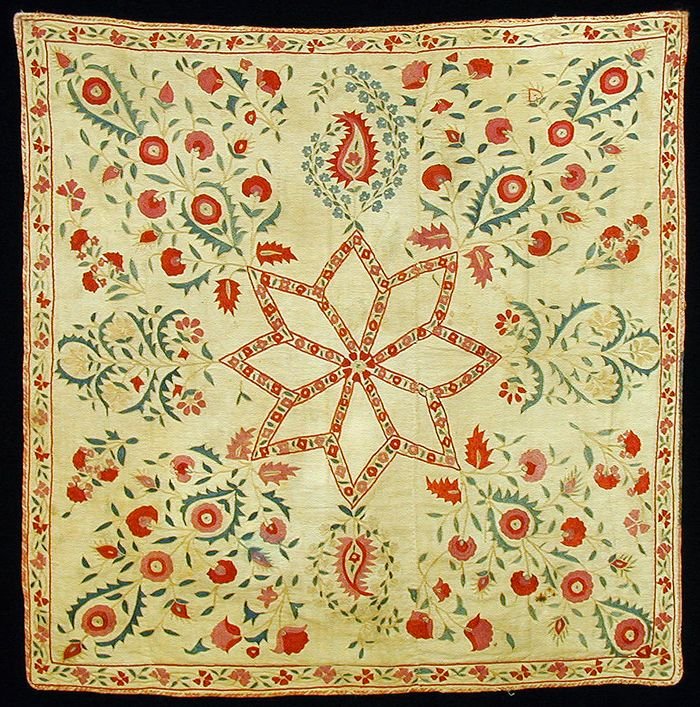
Bukhara embroidery
Embroidery in Bukhara is one of the most interesting in Central Asia. A typical Bukhara design consists of flowers on thin branches evenly distributed over the surface of the fabric, or round rosettes framed by long stems. The color scheme uses a harmonious combination of blue, gray and light yellow with red, raspberry and green colors.
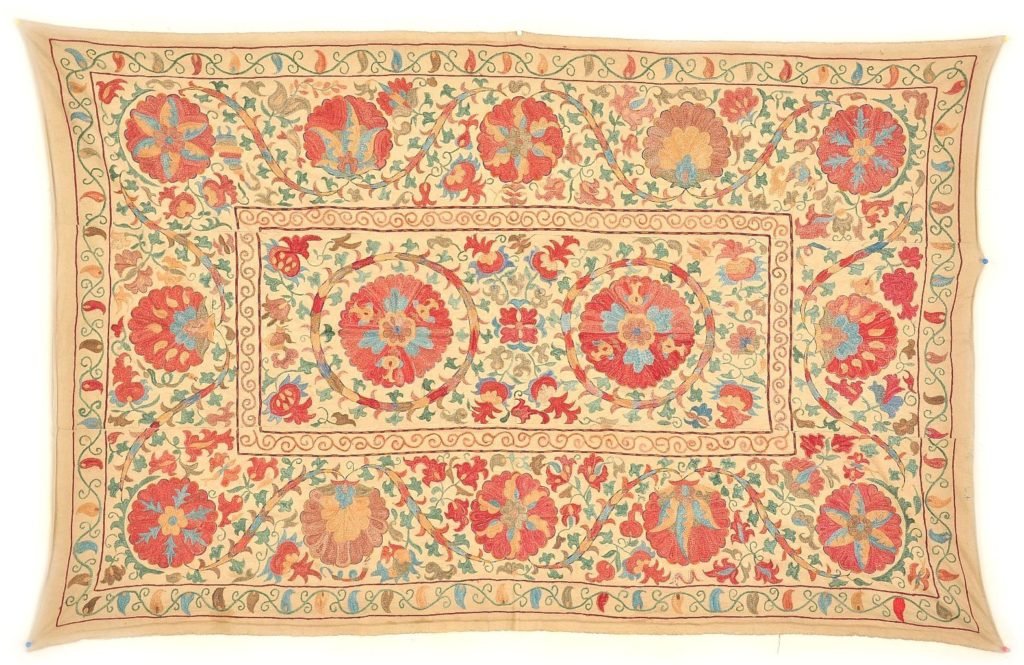
Samarkand embroidery
Samarkand’s embroidery differs from the works from Nurata and Bukhara in a significantly simplified design, consisting of sockets surrounded by leafy circles and a limited palette with a predominance of lilac color.

Surkhandarya embroidery
A variety of original, surprisingly colorful and bright ornaments endowed with an ancient magical meaning is characteristic of modern Surkhandarya embroidery. Surkhandarya style of embroidery is rich in floral ornaments with all kinds of floral variations: egizgul, lolagul, pakhtagul, oigul and many others. Surkhandarya craftsmen managed to preserve almost all kinds of traditional motifs in the design of all kinds of products such as: Baysun skullcaps (made using the “piltta” technique), belbogs (waist scarves), oina-khalta (bags for mirrors), suzani (wall cloth partitions), bugdzhoma (bedspreads for storing things).
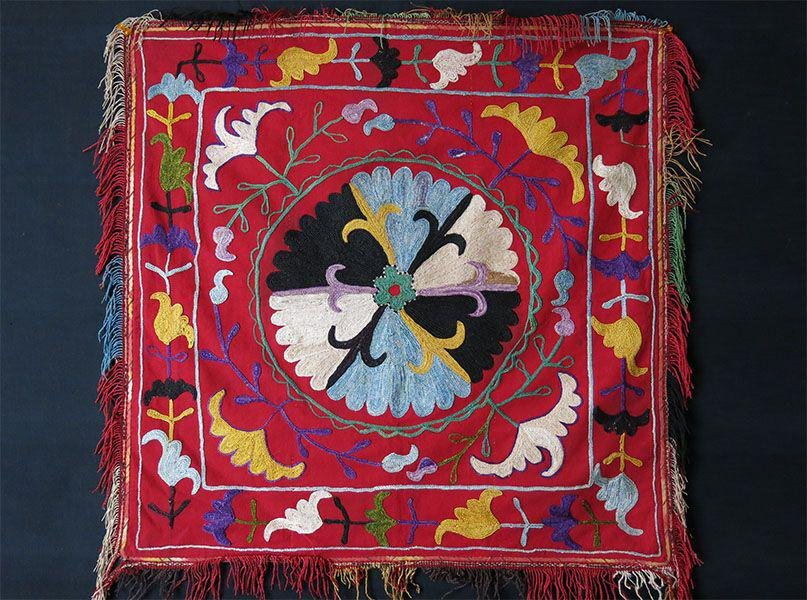
Shakhrisabz embroidery
In the ornament of embroidery of Shakhrisabz, as well as Samarkand, the central place is occupied by a large outlet with multi-colored details framed by blue leafy garlands. Sometimes it is plant motifs with a frame in the form of large ornaments and circles. In Shakhrisabz, several varieties of skullcaps were also created. The color palette of embroidery is based on several basic tones: raspberry, green and red.

Tashkent embroidery
In Tashkent, there are two types of large decorative embroideries such as suzani -palak (from the word “falak”, which means “heaven”) and gulkurpa. The entire surface of Tashkent palak embroidery is covered with solid embroidered symbols and dark red circles. The composition of the gulkurpa is arranged in the form of a central star or a circle with floral branches, leaving a large area of clean fabric visible.
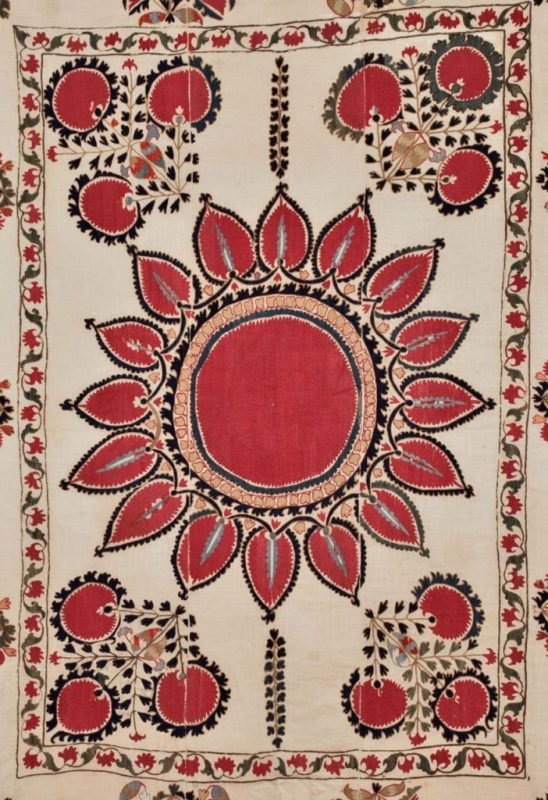
Ferghana embroidery
Embroideries from the Ferghana Valley are distinguished by a delicate graphic design of twigs and concentric rings with large free areas of the background. The works of Ferghana craftswomen are executed on a colored background. Mostly ruijos and skullcaps are produced. Large embroideries such as gulkurpa and suzani are less common. Decorative Ferghana embroidery with its thin, elegant lines resembles skullcaps. Their color uses a contrast of light and dark tones. Women artists (kalam koshi) worked on the embroidery design. Their art was respected, knowledge often passed from mother to daughter. Depending on the selected product, kalam koshi chose the shape, size and composition of the embroidery.
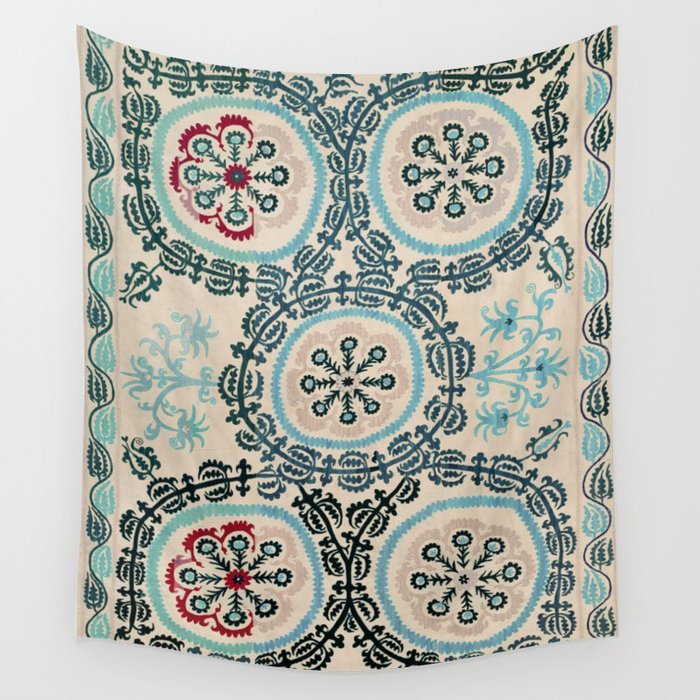
Kashkadarya embroidery
The traditional Kashkadarya school of embroidery is an original interweaving of local, Samarkand and Surkhandarya schools of design of ornaments. Two types of ornaments are mainly used in the decor of Kashkadarya suzanis: rosette and freely placed patterns with floral (doiragul, archagul, kalampir gul, raikhon ghul, olvali) motifs. A relatively new trend that arose in the Soviet period is the images of animals: birds (captara suzane) or scorpions. At present, these motifs are practically not used. Sometimes for a fabric base they use white satin or blue silk, which are then decorated with beautiful patterns from floral ornaments, images of pomegranate with all kinds of ornate elements.


